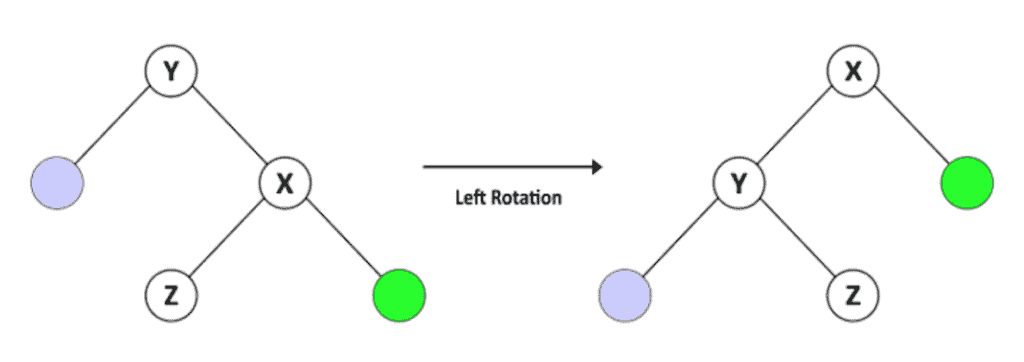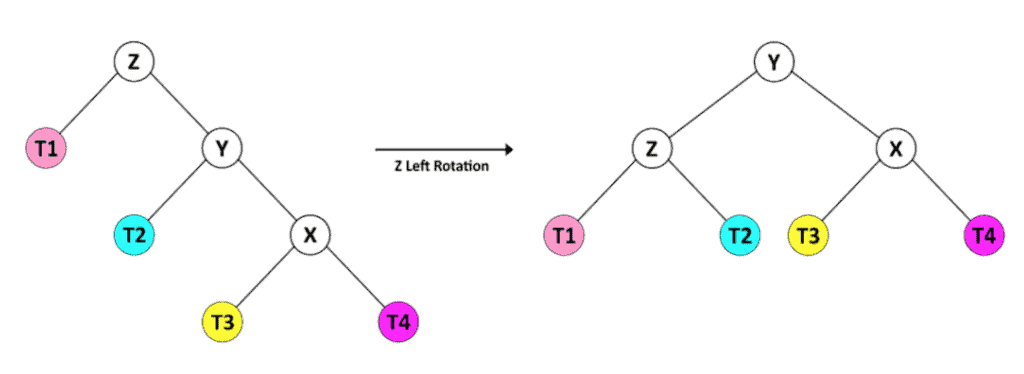1. 简介
本文将深入介绍 AVL 树,重点讲解其在 Java 中的实现,涵盖插入、删除和查找等核心操作。AVL 树作为最早提出的自平衡二叉搜索树之一,能有效避免普通 BST 在极端情况下退化为链表的问题,从而保证操作效率稳定。
2. 什么是 AVL 树?
AVL 树是以其发明者 Adelson-Velsky 和 Landis 命名的自平衡二叉搜索树(BST)。
✅ 自平衡的核心在于:每次插入或删除节点后,树会通过特定规则自动调整结构,确保整体高度维持在
O(log N)级别。
普通 BST 的最坏时间复杂度取决于树的高度。设想一种极端情况:所有节点都只有左子或右子,此时树退化为链表,高度为 N,查找时间变为 O(N),性能急剧下降。而 AVL 树的目标就是将最大高度控制在接近 log(N)。
每个节点都有一个平衡因子(Balance Factor),定义为:
平衡因子 = 右子树高度 - 左子树高度
⚠️ 在 AVL 树中,任意节点的平衡因子只能是 -1、0 或 1。一旦某个节点的平衡因子变为 2 或 -2,就必须通过旋转操作进行重新平衡。
下面是节点和 AVL 树的基本结构定义:
public class Node {
int key;
int height;
Node left;
Node right;
public Node(int key) {
this.key = key;
this.height = 0;
}
}
public class AVLTree {
private Node root;
void updateHeight(Node n) {
n.height = 1 + Math.max(height(n.left), height(n.right));
}
int height(Node n) {
return n == null ? -1 : n.height;
}
int getBalance(Node n) {
return (n == null) ? 0 : height(n.right) - height(n.left);
}
}
3. 如何平衡 AVL 树?
AVL 树在每次插入或删除后,都会从修改点向上回溯,检查路径上每个节点的平衡因子。若发现某节点平衡因子为 2 或 -2,则立即触发旋转(Rotation)操作进行调整。
主要旋转方式有两种:
- ✅ 左旋转(Left Rotation)
- ✅ 右旋转(Right Rotation)
3.1 右旋转
右旋转适用于左子树过高的情况。
假设有一棵子树 T1,根节点为 Y,X 是 Y 的左子节点,Z 是 X 的右子节点。根据 BST 性质,有 X < Z < Y。
对 Y 执行右旋转后,得到新结构 T2:X 成为新根,Y 成为 X 的右子,Z 成为 Y 的左子。BST 的顺序关系依然成立。
右旋转代码实现如下:
Node rotateRight(Node y) {
Node x = y.left;
Node z = x.right;
x.right = y;
y.left = z;
updateHeight(y);
updateHeight(x);
return x;
}
3.2 左旋转
左旋转用于处理右子树过高的情况。
假设子树 T1 中,Y 为根,X 是 Y 的右子,Z 是 X 的左子。此时有 Y < Z < X。
对 Y 执行左旋转后,X 成为新根,Y 成为 X 的左子,Z 成为 Y 的右子。BST 性质保持不变。
左旋转实现:
Node rotateLeft(Node y) {
Node x = y.right;
Node z = x.left;
x.left = y;
y.right = z;
updateHeight(y);
updateHeight(x);
return x;
}
3.3 重新平衡策略
单次旋转不足以应对所有失衡场景,实际中需要组合使用。主要分为四种情况:
情况一:右右(RR)——左旋
- 条件:节点 Z 的平衡因子为 2,且其右子 Y 的右子更高
- 操作:对 Z 执行一次
rotateLeft
情况二:右左(RL)——先右旋再左旋
- 条件:节点 Z 的平衡因子为 2,但其右子 Y 的左子更高
- 操作:
- 对 Y 执行
rotateRight - 对 Z 执行
rotateLeft
- 对 Y 执行
情况三:左左(LL)——右旋
- 条件:节点 Z 的平衡因子为 -2,且其左子 Y 的左子更高
- 操作:对 Z 执行一次
rotateRight
情况四:左右(LR)——先左旋再右旋
- 条件:节点 Z 的平衡因子为 -2,但其左子 Y 的右子更高
- 操作:
- 对 Y 执行
rotateLeft - 对 Z 执行
rotateRight
- 对 Y 执行
最终的 rebalance 方法整合了上述所有情况:
Node rebalance(Node z) {
updateHeight(z);
int balance = getBalance(z);
if (balance > 1) {
if (height(z.right.right) > height(z.right.left)) {
z = rotateLeft(z);
} else {
z.right = rotateRight(z.right);
z = rotateLeft(z);
}
} else if (balance < -1) {
if (height(z.left.left) > height(z.left.right))
z = rotateRight(z);
else {
z.left = rotateLeft(z.left);
z = rotateRight(z);
}
}
return z;
}
✅ 关键点:每次插入或删除后,必须从变更节点一路向上回溯到根,对路径上的每个节点调用
rebalance。
4. 插入节点
插入操作遵循 BST 基本规则:
- 从根开始,根据 key 大小决定向左或向右查找插入位置
- 找到合适位置后创建新节点
- 插入完成后,从下往上对路径上的每个节点执行
rebalance
Node insert(Node root, int key) {
if (root == null) {
return new Node(key);
} else if (root.key > key) {
root.left = insert(root.left, key);
} else if (root.key < key) {
root.right = insert(root.right, key);
} else {
throw new RuntimeException("duplicate Key!");
}
return rebalance(root);
}
⚠️ AVL 树中 key 必须唯一,重复插入会抛出异常。
由于树始终保持平衡,插入操作的时间复杂度为 **O(log N)**。
5. 删除节点
删除逻辑比插入稍复杂,需分情况处理:
- ✅ 叶子节点:直接删除
- ✅ 仅有一个子节点:用子节点替代
- ✅ 有两个子节点:找到右子树中的最小节点(最左节点)X,用 X 的值覆盖当前节点 Z,然后递归删除 X
删除后同样需要从下往上 rebalance。
Node delete(Node node, int key) {
if (node == null) {
return node;
} else if (node.key > key) {
node.left = delete(node.left, key);
} else if (node.key < key) {
node.right = delete(node.right, key);
} else {
if (node.left == null || node.right == null) {
node = (node.left == null) ? node.right : node.left;
} else {
Node mostLeftChild = mostLeftChild(node.right);
node.key = mostLeftChild.key;
node.right = delete(node.right, node.key);
}
}
if (node != null) {
node = rebalance(node);
}
return node;
}
Node mostLeftChild(Node node) {
return node.left == null ? node : mostLeftChild(node.left);
}
✅ 时间复杂度同样是 **O(log N)**,得益于平衡结构。
6. 查找节点
AVL 树的查找与普通 BST 完全一致,属于简单粗暴的二分查找:
- 从根开始比较
- 相等则返回,key 更大则向右,否则向左
- 直到找到或为空
Node find(int key) {
Node current = root;
while (current != null) {
if (current.key == key) {
break;
}
current = current.key < key ? current.right : current.left;
}
return current;
}
查找时间复杂度为 **O(log N)**,性能稳定,无最坏情况。
7. 总结
本文完整实现了 AVL 树的核心操作:插入、删除与查找。通过严格的平衡因子控制和四种旋转策略,AVL 树在动态数据场景下依然能保证高效的 O(log N) 操作性能。
✅ 适用场景:适合读多写少、对查询性能要求极高的系统。
⚠️ 注意:频繁插入删除可能引发较多旋转,需权衡维护成本。
完整代码示例可参考 GitHub 仓库:https://github.com/baeldung/java-algorithms/tree/master/avl-tree





